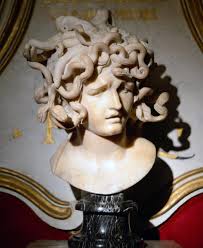My, My, Medusa: a Story of Curses and Stone


When you think of Medusa, you’re probably thinking of a woman with snakes for hair (as depicted in the image on the left). Which, is true, but you’re missing so much of the story.
But, which version of the story to tell? There are many, depending on if you’re looking at the Roman version, the Greek version, or the various other versions of the myths that changed the details.
The myths all begin the same: Phorcys and Ceto, two primordial sea gods, had three children called the Gorgons. There was Stheno, Euryale, and Medusa. For whatever reason, Medusa was the only one of the Gorgons to be mortal, and not look like the hideous beasts her sisters were.
After this, the versions of the story begin to be different. For some, I am including a trigger warning for sexual assault, so skip those versions if you need to.
In one version of the story, Medusa was so beautiful that she caught the eye of the Sea God Poseidon, and Poseidon took her to a temple of Athena to “ravage” her. If you read my last blog post, you know that Poseidon and Athena have a centuries-long rivalry, which is probably why he took Medusa to Athena’s temple specifically.
To do anything scandalous in a God’s temple is sacrilege, but even more so with Athena due to the fact that she is one of the maiden Goddesses, so it was incredibly insulting.
Athena then cursed Medusa to lose her beauty (and her mortality) and become a full Gorgon like her sisters. Her gaze turned men to stone, her hair turned into snakes, and she sprouted wings, fangs, and claws.
In two other versions of the story, Medusa was a priestess for Athena, and worked in one of her temples. The versions differ, however, in the context of how Athena “cursed” Medusa.
In one of them, Medusa broke her vow of celibacy by having an affair with Poseidon in the temple, where Athena then cursed Medusa to be a true Gorgon.
(TW) In another, however, Poseidon raped Medusa as a means to get back at Athena for their rivalry. Athena’s “curse” then became more of a blessing, because Medusa could then protect herself from anyone who tried to hurt her by simply looking at them.
No matter which version of the myth you look at, it always ends the same.
 Perseus, son of Danae, daughter of Acrisius the King of Argos, and Zeus. As he was a demigod, it was his destiny to become a hero.
Perseus, son of Danae, daughter of Acrisius the King of Argos, and Zeus. As he was a demigod, it was his destiny to become a hero.
Perseus was sent on a quest to get Medusa’s head. The man who sent him on this quest really wanted Perseus’s mother, and knowing that one look from Medusa would kill Perseus, he saw this as the perfect way to get rid of the boy.
However, Perseus was successful in his quest. He received help from the Gods in his quest: he got the Helm of Invisibility from Hades, a pair of winged sandals from Hermes, a bronze shield from Athena, and a sword from Hephaestus.
He used these gifts to decapitate Medusa (though he did it while she was asleep, so there wasn’t much of a fight).
From Medusa’s head came Pegasus, the Father of all Winged Horses, and in some versions, the Giant Chrysaor was also born from Medusa.
Medusa’s head is often represented as a symbol to ward evil, and the name Medusa in Greek translates to “to guard or protect.” Some say that this comes from the version of the myth where she was given her Gorgon powers as a means of protection rather than a curse, and others say that having her head as a symbol will turn evil to stone.
Medusa was the kickstart for Perseus’s long history of quests that would lead to him being one of the greatest heroes of all time. As always, that is a story for another time.
Thank you for reading, and I hope to see you again soon. Αντίο, Σοφία.



